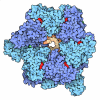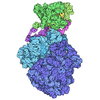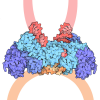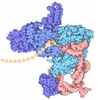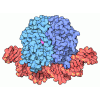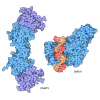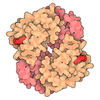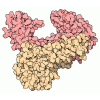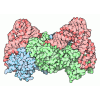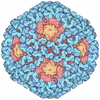+ データを開く
データを開く
- 基本情報
基本情報
| 登録情報 | データベース: PDB / ID: 7ad8 | ||||||
|---|---|---|---|---|---|---|---|
| タイトル | Core TFIIH-XPA-DNA complex with modelled p62 subunit | ||||||
 要素 要素 |
| ||||||
 キーワード キーワード | DNA BINDING PROTEIN / DNA repair / transcription factor | ||||||
| 機能・相同性 |  機能・相同性情報 機能・相同性情報nucleotide-excision repair factor 1 complex / nucleotide-excision repair involved in interstrand cross-link repair / nucleotide-excision repair, DNA damage recognition / MMXD complex / core TFIIH complex portion of holo TFIIH complex / Cytosolic iron-sulfur cluster assembly / central nervous system myelin formation / positive regulation of mitotic recombination / hair cell differentiation / hair follicle maturation ...nucleotide-excision repair factor 1 complex / nucleotide-excision repair involved in interstrand cross-link repair / nucleotide-excision repair, DNA damage recognition / MMXD complex / core TFIIH complex portion of holo TFIIH complex / Cytosolic iron-sulfur cluster assembly / central nervous system myelin formation / positive regulation of mitotic recombination / hair cell differentiation / hair follicle maturation / nucleotide-excision repair factor 3 complex / nucleotide-excision repair, preincision complex assembly / CAK-ERCC2 complex / embryonic cleavage / DNA 5'-3' helicase / UV protection / regulation of cyclin-dependent protein serine/threonine kinase activity / transcription factor TFIIH core complex / transcription factor TFIIH holo complex / G protein-coupled receptor internalization / nuclear thyroid hormone receptor binding / UV-damage excision repair / transcription preinitiation complex / RNA Polymerase I Transcription Termination / DNA 3'-5' helicase / regulation of mitotic cell cycle phase transition / RNA polymerase II general transcription initiation factor activity / transcription factor TFIID complex / erythrocyte maturation / 3'-5' DNA helicase activity / hematopoietic stem cell proliferation / spinal cord development / RNA Pol II CTD phosphorylation and interaction with CE during HIV infection / RNA Pol II CTD phosphorylation and interaction with CE / HIV Transcription Initiation / RNA Polymerase II HIV Promoter Escape / Transcription of the HIV genome / RNA Polymerase II Promoter Escape / RNA Polymerase II Transcription Pre-Initiation And Promoter Opening / RNA Polymerase II Transcription Initiation / RNA Polymerase II Transcription Initiation And Promoter Clearance / Formation of the Early Elongation Complex / Formation of the HIV-1 Early Elongation Complex / bone mineralization / mRNA Capping / ATPase activator activity / DNA topological change / intrinsic apoptotic signaling pathway by p53 class mediator / RNA Polymerase I Transcription Initiation / hematopoietic stem cell differentiation / embryonic organ development / positive regulation of transcription initiation by RNA polymerase II / protein localization to nucleus / Tat-mediated elongation of the HIV-1 transcript / Formation of HIV-1 elongation complex containing HIV-1 Tat / transcription elongation by RNA polymerase I / response to UV / Formation of HIV elongation complex in the absence of HIV Tat / transcription by RNA polymerase I / RNA Polymerase II Transcription Elongation / Formation of RNA Pol II elongation complex / hormone-mediated signaling pathway / transcription-coupled nucleotide-excision repair / extracellular matrix organization / RNA Polymerase II Pre-transcription Events / DNA helicase activity / insulin-like growth factor receptor signaling pathway / determination of adult lifespan / post-embryonic development / maturation of SSU-rRNA from tricistronic rRNA transcript (SSU-rRNA, 5.8S rRNA, LSU-rRNA) / nucleotide-excision repair / TP53 Regulates Transcription of DNA Repair Genes / chromosome segregation / transcription initiation at RNA polymerase II promoter / transcription elongation by RNA polymerase II / promoter-specific chromatin binding / RNA Polymerase I Promoter Escape / cellular response to gamma radiation / base-excision repair / NoRC negatively regulates rRNA expression / response to toxic substance / Dual Incision in GG-NER / Transcription-Coupled Nucleotide Excision Repair (TC-NER) / Formation of TC-NER Pre-Incision Complex / multicellular organism growth / spindle / Formation of Incision Complex in GG-NER / intrinsic apoptotic signaling pathway in response to DNA damage / sequence-specific double-stranded DNA binding / Dual incision in TC-NER / Gap-filling DNA repair synthesis and ligation in TC-NER / intracellular protein localization / 4 iron, 4 sulfur cluster binding / response to oxidative stress / double-stranded DNA binding / 5'-3' DNA helicase activity / protein-macromolecule adaptor activity / in utero embryonic development / damaged DNA binding / transcription by RNA polymerase II 類似検索 - 分子機能 | ||||||
| 生物種 |  Homo sapiens (ヒト) Homo sapiens (ヒト) | ||||||
| 手法 | 電子顕微鏡法 / 単粒子再構成法 / クライオ電子顕微鏡法 / 解像度: 3.5 Å | ||||||
 データ登録者 データ登録者 | Koelmel, W. / Kuper, J. / Kisker, C. | ||||||
| 資金援助 |  ドイツ, 1件 ドイツ, 1件
| ||||||
 引用 引用 |  ジャーナル: Nucleic Acids Res / 年: 2020 ジャーナル: Nucleic Acids Res / 年: 2020タイトル: The TFIIH subunits p44/p62 act as a damage sensor during nucleotide excision repair. 著者: Jamie T Barnett / Jochen Kuper / Wolfgang Koelmel / Caroline Kisker / Neil M Kad /   要旨: Nucleotide excision repair (NER) in eukaryotes is orchestrated by the core form of the general transcription factor TFIIH, containing the helicases XPB, XPD and five 'structural' subunits, p62, p44, ...Nucleotide excision repair (NER) in eukaryotes is orchestrated by the core form of the general transcription factor TFIIH, containing the helicases XPB, XPD and five 'structural' subunits, p62, p44, p34, p52 and p8. Recent cryo-EM structures show that p62 makes extensive contacts with p44 and in part occupies XPD's DNA binding site. While p44 is known to regulate the helicase activity of XPD during NER, p62 is thought to be purely structural. Here, using helicase and adenosine triphosphatase assays we show that a complex containing p44 and p62 enhances XPD's affinity for dsDNA 3-fold over p44 alone. Remarkably, the relative affinity is further increased to 60-fold by dsDNA damage. Direct binding studies show this preference derives from p44/p62's high affinity (20 nM) for damaged ssDNA. Single molecule imaging of p44/p62 complexes without XPD reveals they bind to and randomly diffuse on DNA, however, in the presence of UV-induced DNA lesions these complexes stall. Combined with the analysis of a recent cryo-EM structure, we suggest that p44/p62 acts as a novel DNA-binding entity that enhances damage recognition in TFIIH. This revises our understanding of TFIIH and prompts investigation into the core subunits for an active role during DNA repair and/or transcription. | ||||||
| 履歴 |
|
- 構造の表示
構造の表示
| ムービー |
 ムービービューア ムービービューア |
|---|---|
| 構造ビューア | 分子:  Molmil Molmil Jmol/JSmol Jmol/JSmol |
- ダウンロードとリンク
ダウンロードとリンク
- ダウンロード
ダウンロード
| PDBx/mmCIF形式 |  7ad8.cif.gz 7ad8.cif.gz | 505.5 KB | 表示 |  PDBx/mmCIF形式 PDBx/mmCIF形式 |
|---|---|---|---|---|
| PDB形式 |  pdb7ad8.ent.gz pdb7ad8.ent.gz | 390.9 KB | 表示 |  PDB形式 PDB形式 |
| PDBx/mmJSON形式 |  7ad8.json.gz 7ad8.json.gz | ツリー表示 |  PDBx/mmJSON形式 PDBx/mmJSON形式 | |
| その他 |  その他のダウンロード その他のダウンロード |
-検証レポート
| 文書・要旨 |  7ad8_validation.pdf.gz 7ad8_validation.pdf.gz | 808.6 KB | 表示 |  wwPDB検証レポート wwPDB検証レポート |
|---|---|---|---|---|
| 文書・詳細版 |  7ad8_full_validation.pdf.gz 7ad8_full_validation.pdf.gz | 823.2 KB | 表示 | |
| XML形式データ |  7ad8_validation.xml.gz 7ad8_validation.xml.gz | 67.1 KB | 表示 | |
| CIF形式データ |  7ad8_validation.cif.gz 7ad8_validation.cif.gz | 104.4 KB | 表示 | |
| アーカイブディレクトリ |  https://data.pdbj.org/pub/pdb/validation_reports/ad/7ad8 https://data.pdbj.org/pub/pdb/validation_reports/ad/7ad8 ftp://data.pdbj.org/pub/pdb/validation_reports/ad/7ad8 ftp://data.pdbj.org/pub/pdb/validation_reports/ad/7ad8 | HTTPS FTP |
-関連構造データ
| 関連構造データ |  4970M M: このデータのモデリングに利用したマップデータ |
|---|---|
| 類似構造データ |
- リンク
リンク
- 集合体
集合体
| 登録構造単位 | 
|
|---|---|
| 1 |
|
- 要素
要素
-DNA鎖 , 2種, 2分子 JK
| #1: DNA鎖 | 分子量: 15036.663 Da / 分子数: 1 / 由来タイプ: 合成 / 由来: (合成)  Homo sapiens (ヒト) Homo sapiens (ヒト) |
|---|---|
| #2: DNA鎖 | 分子量: 15075.698 Da / 分子数: 1 / 由来タイプ: 合成 / 由来: (合成)  Homo sapiens (ヒト) Homo sapiens (ヒト) |
-タンパク質 , 3種, 3分子 ABG
| #3: タンパク質 | 分子量: 89404.734 Da / 分子数: 1 / 由来タイプ: 組換発現 / 由来: (組換発現)  Homo sapiens (ヒト) / 遺伝子: ERCC3, XPB, XPBC / 発現宿主: Homo sapiens (ヒト) / 遺伝子: ERCC3, XPB, XPBC / 発現宿主:  Trichoplusia ni (イラクサキンウワバ) / 参照: UniProt: P19447, DNA helicase Trichoplusia ni (イラクサキンウワバ) / 参照: UniProt: P19447, DNA helicase |
|---|---|
| #5: タンパク質 | 分子量: 87021.078 Da / 分子数: 1 / 由来タイプ: 組換発現 / 由来: (組換発現)  Homo sapiens (ヒト) / 遺伝子: ERCC2, XPD, XPDC / 発現宿主: Homo sapiens (ヒト) / 遺伝子: ERCC2, XPD, XPDC / 発現宿主:  Trichoplusia ni (イラクサキンウワバ) / 参照: UniProt: P18074, DNA helicase Trichoplusia ni (イラクサキンウワバ) / 参照: UniProt: P18074, DNA helicase |
| #9: タンパク質 | 分子量: 31422.053 Da / 分子数: 1 / 由来タイプ: 組換発現 / 由来: (組換発現)  Homo sapiens (ヒト) / 遺伝子: XPA, XPAC / 発現宿主: Homo sapiens (ヒト) / 遺伝子: XPA, XPAC / 発現宿主:  Trichoplusia ni (イラクサキンウワバ) / 参照: UniProt: P23025 Trichoplusia ni (イラクサキンウワバ) / 参照: UniProt: P23025 |
-General transcription factor IIH subunit ... , 5種, 5分子 FEDCI
| #4: タンパク質 | 分子量: 8060.362 Da / 分子数: 1 / 由来タイプ: 組換発現 / 由来: (組換発現)  Homo sapiens (ヒト) / 遺伝子: GTF2H5, C6orf175, TTDA / 発現宿主: Homo sapiens (ヒト) / 遺伝子: GTF2H5, C6orf175, TTDA / 発現宿主:  Trichoplusia ni (イラクサキンウワバ) / 参照: UniProt: Q6ZYL4 Trichoplusia ni (イラクサキンウワバ) / 参照: UniProt: Q6ZYL4 |
|---|---|
| #6: タンパク質 | 分子量: 34416.008 Da / 分子数: 1 / 由来タイプ: 組換発現 / 由来: (組換発現)  Homo sapiens (ヒト) / 遺伝子: GTF2H3 / 発現宿主: Homo sapiens (ヒト) / 遺伝子: GTF2H3 / 発現宿主:  Trichoplusia ni (イラクサキンウワバ) / 参照: UniProt: Q13889 Trichoplusia ni (イラクサキンウワバ) / 参照: UniProt: Q13889 |
| #7: タンパク質 | 分子量: 44481.996 Da / 分子数: 1 / 由来タイプ: 組換発現 / 由来: (組換発現)  Homo sapiens (ヒト) / 遺伝子: GTF2H2, BTF2P44 / 発現宿主: Homo sapiens (ヒト) / 遺伝子: GTF2H2, BTF2P44 / 発現宿主:  Trichoplusia ni (イラクサキンウワバ) / 参照: UniProt: Q13888 Trichoplusia ni (イラクサキンウワバ) / 参照: UniProt: Q13888 |
| #8: タンパク質 | 分子量: 52245.156 Da / 分子数: 1 / 由来タイプ: 組換発現 / 由来: (組換発現)  Homo sapiens (ヒト) / 遺伝子: GTF2H4 / 発現宿主: Homo sapiens (ヒト) / 遺伝子: GTF2H4 / 発現宿主:  Trichoplusia ni (イラクサキンウワバ) / 参照: UniProt: Q92759 Trichoplusia ni (イラクサキンウワバ) / 参照: UniProt: Q92759 |
| #10: タンパク質 | 分子量: 62116.492 Da / 分子数: 1 / 由来タイプ: 組換発現 / 由来: (組換発現)  Homo sapiens (ヒト) / 遺伝子: GTF2H1, BTF2 / 発現宿主: Homo sapiens (ヒト) / 遺伝子: GTF2H1, BTF2 / 発現宿主:  Trichoplusia ni (イラクサキンウワバ) / 参照: UniProt: P32780 Trichoplusia ni (イラクサキンウワバ) / 参照: UniProt: P32780 |
-非ポリマー , 2種, 7分子 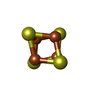


| #11: 化合物 | ChemComp-SF4 / |
|---|---|
| #12: 化合物 | ChemComp-ZN / |
-詳細
| 研究の焦点であるリガンドがあるか | N |
|---|
-実験情報
-実験
| 実験 | 手法: 電子顕微鏡法 |
|---|---|
| EM実験 | 試料の集合状態: PARTICLE / 3次元再構成法: 単粒子再構成法 |
- 試料調製
試料調製
| 構成要素 |
| ||||||||||||||||||||||||
|---|---|---|---|---|---|---|---|---|---|---|---|---|---|---|---|---|---|---|---|---|---|---|---|---|---|
| 分子量 | 実験値: NO | ||||||||||||||||||||||||
| 由来(天然) |
| ||||||||||||||||||||||||
| 由来(組換発現) |
| ||||||||||||||||||||||||
| 緩衝液 | pH: 7.5 | ||||||||||||||||||||||||
| 試料 | 包埋: NO / シャドウイング: NO / 染色: NO / 凍結: YES | ||||||||||||||||||||||||
| 急速凍結 | 凍結剤: ETHANE |
- 電子顕微鏡撮影
電子顕微鏡撮影
| 実験機器 |  モデル: Titan Krios / 画像提供: FEI Company |
|---|---|
| 顕微鏡 | モデル: FEI TITAN KRIOS |
| 電子銃 | 電子線源:  FIELD EMISSION GUN / 加速電圧: 300 kV / 照射モード: FLOOD BEAM FIELD EMISSION GUN / 加速電圧: 300 kV / 照射モード: FLOOD BEAM |
| 電子レンズ | モード: BRIGHT FIELD |
| 撮影 | 電子線照射量: 41 e/Å2 フィルム・検出器のモデル: GATAN K2 SUMMIT (4k x 4k) |
- 解析
解析
| CTF補正 | タイプ: PHASE FLIPPING AND AMPLITUDE CORRECTION |
|---|---|
| 3次元再構成 | 解像度: 3.5 Å / 解像度の算出法: FSC 0.143 CUT-OFF / 粒子像の数: 227776 / 対称性のタイプ: POINT |
 ムービー
ムービー コントローラー
コントローラー




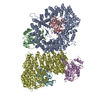


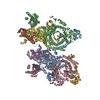



 PDBj
PDBj

